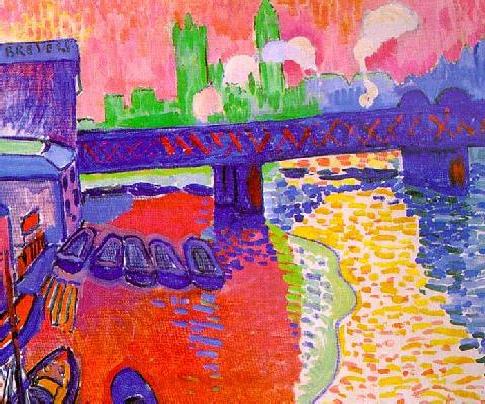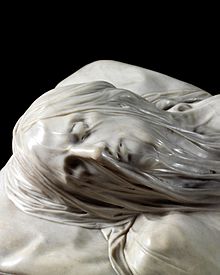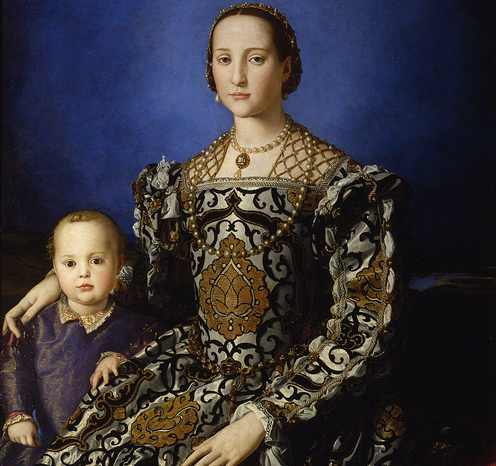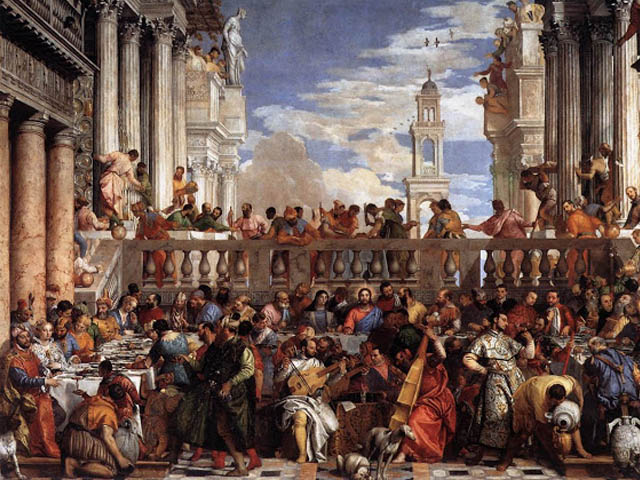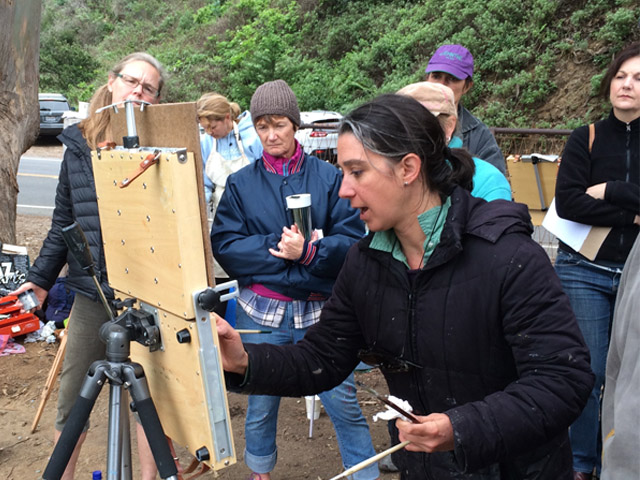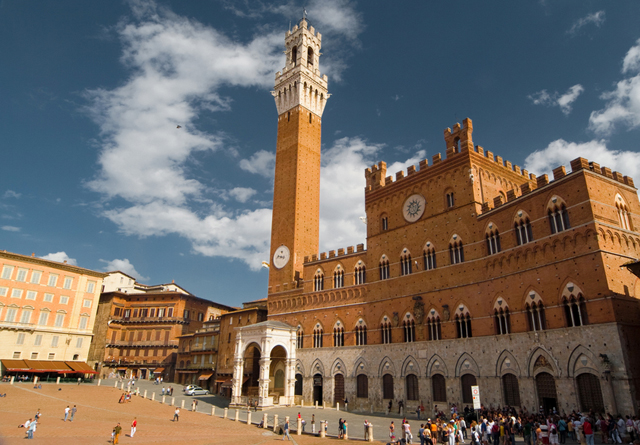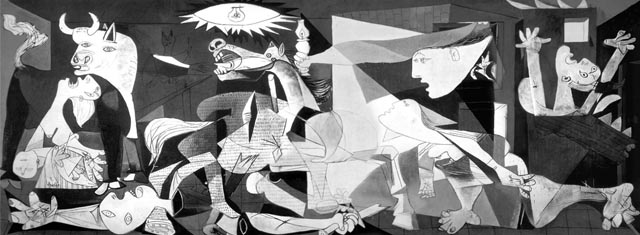
“Un’opera d’arte deve far reagire un uomo…
deve agitarlo e scuoterlo.”
“A work of art must make a man react…
it must agitate him and shake him up.”
La Guernica è senza dubbio una delle opera d’arte più famose di Pablo Picasso. È una potente dichiarazione contro la guerra ed è stata dipinta al seguito del bombardamento indiscriminato nazista della città basca di Guernica durante la guerra civile spagnola alla fine degli anni Trenta. Picasso dipinse l’enorme quadro come pezzo centrale per l’esposizione universale di Parigi del 1937. Il murale, che mostra un cavallo urlante, madri lamentose e bambini morti, cattura graficamente le tragedie della guerra e la distruzione insensata di vite innocenti.
The Guernica is undoubtedly one of Pablo Picasso’s most famous works of art. It is a powerful antiwar statement and was painted in reaction to the Nazi’s casual bombing of the Basque town of Guernica during the Spanish Civil War in the late thirties. Picasso painted the enormous mural as a centerpiece for the Spanish Pavilion at the 1937 World’s Fair held in Paris. The painting, showing screaming horses, wailing mothers, and dead children graphically capture the tragedies of war and the senseless destruction of innocent lives.
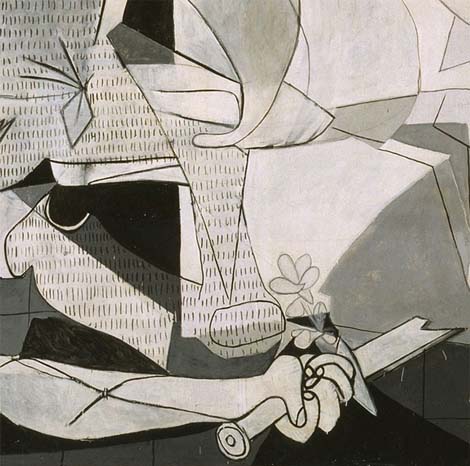
Per mettere il dipinto in un contesto storico, Guernica è una piccolo città nei Paesi Baschi. Durante la guerra civile spagnola, fu considerata una roccaforte per il movimento di resistenza repubblicano che combatté contro la dittatura nazionalista del generale Francisco Franco. Franco era in linea con Hitler e sperava di riportare la Spagna ai suoi giorni d’oro, con un rigido sistema di ordine pubblico e valori familiari tradizionali cattolici. Ma le tattiche di Franco erano implacabili. Dalla sua ascesa al potere, ha attuato politiche che furano responsabili della repressione e della morte di 400.000 oppositori e dissident politici attraverso il ricorso al lavoro forzato e alle esecuzioni nei campi di concentramento gestiti da suo regime.
To put the painting in historical context, Guernica is a small town in the Basque Country. During the Spanish Civil War, it was regarded as a stronghold for the Republican resistance movement that fought against General Francisco Franco’s Nationalist dictatorship. Franco was aligned with Hitler and hoped to return Spain to its golden days, based on a rigid system of law and order and traditional Catholic family values. But, Franco’s tactics were relentless. Upon his rise to power, he implemented policies that were responsible for the repression and deaths of as many as 400,000 political opponents and dissenters through the use of forced labor and executions in concentration camps operated by his regime.
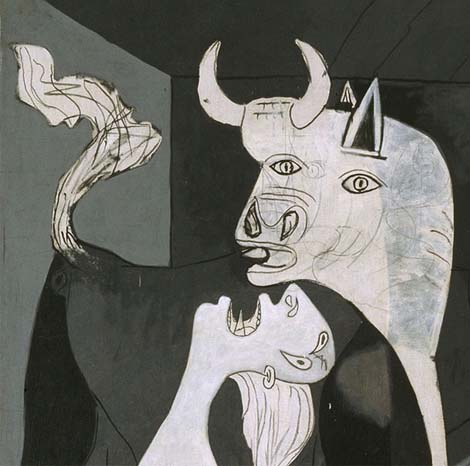
In una di queste dimostrazioni di potere e aggressione, lunedì 26 Aprile 1937, aerei da guerra della Legione Condo tedesca—la Germania è stata un alleato della Spagna—bombardarono Guernica per circa due ore. I tedeschi stavano sfruttando l’opportunità di assistere Franco nei suoi sforzi per sottomettere i partigiani e testare nuove armi. L’attacco fu controverso in quanto coinvolse civili.
In one such show of power and aggression, on Monday, April 26, 1937, warplanes of the German Condor Legion—Germany was one of Spain’s allies—bombed Guernica for about two hours. The Germans were using the opportunity to assist Franco in his efforts to subdue the partisans as well as test out new weapons. The attack was controversial as it involved civilians.
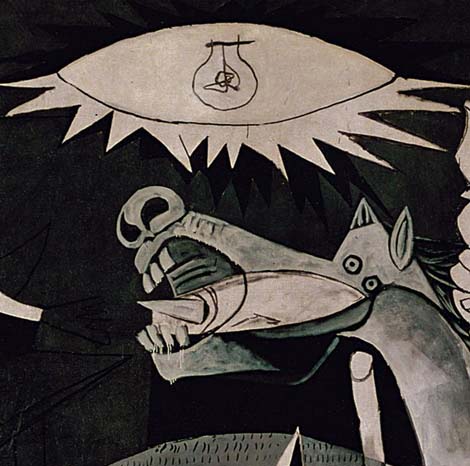
Attraverso l’arte, Picasso è stato in grado di attirare l’attenzione su questo atto violento e aprire gli occhi del mondo agli eventi che si stavano svolgendo nella sua terra natia. Picasso non prova a descrivere la scena come se fosse uno spettatore; al contrario, vuole mostrare il significato della guerra, della repressione e della crudeltà attraverso forme, personaggi e colori—o la mancanza di questi colori. Il murale sovradimensionato è dipinto nei toni del nero e del grigio. Il simbolismo del dipinto è complicato, ma i fattori chiave che si colgono da questo quadro sono il dolore sofferente degli esseri umani. L’immagine non glorifica la vittoria o l’eroismo; piuttosto evidenzia l’impatto della natura distruttiva della guerra.
Through art, Picasso was able to bring attention to this violent act and open the eyes of the world to events that were taking place in his homeland. Picasso doesn’t try to describe the scene as if he were a spectator; instead, he wants to show the meaning of war, suppression, and cruelty through shapes, characters, and color—or lack thereof. The oversized mural is painted in black and gray tones. The symbolism of the painting is complicated, but the key factors that one takes away from this piece are the suffering and human pain. The picture does not glorify victory or heroism; rather it highlights the impact of war’s destructive nature.
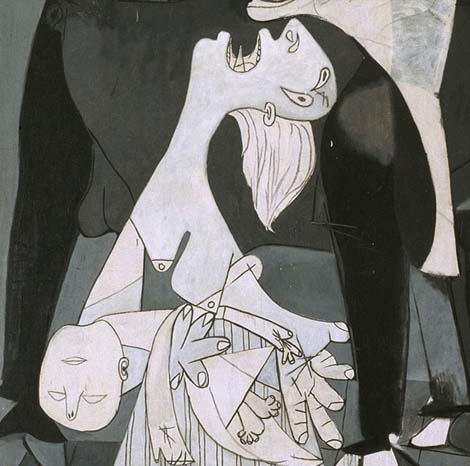
La Guernica acquisì una certa notorietà a Parigi alla “World’s Fair” e per due anni fu esposta in Europa. Nel 1939 il governo di Franco sconfisse il movimento repubblicano e il suo esercito prese il controllo del Paese e che non era sicuro che il murale fosse restituito in Spagna. All’inizio della seconda Guerra mondiale, non era neanche sicuro che rimanesse in Europa fu portato negli Stati Uniti e fu esposto per un decennio al MoMA di New York.
The Guernica gained some notoriety in Paris at the World’s Fair, and for two years it was on display in Europe. In 1939 Franco’s government defeated the Republican movement and his army took control of the country and it wasn’t safe for the mural to be returned to Spain. At the onset of the Second World War, it wasn’t safe for it to remain in Europe either and it traveled to the United States where it was exhibited for decades in the Museum of Modern Art (MoMA) in New York.
Picasso credeva fermamente che la pittura appartenesse al popolo spagnolo, ma fu solo nel 1981, molti anni dopo la morte di Franco, che il quadro fu finalmente restituito alla Spagna. Ora può essere visto al Museo Nacional Centro de Arte Reina Sofia a Madrid.
Picasso firmly believed that painting belonged to the people of Spain, but it wasn’t until 1981, several years after the death of Franco that the mural was finally returned to Spain. It can now be seen at the Museo Nacional Centro de Arte Reina Sofia in Madrid.
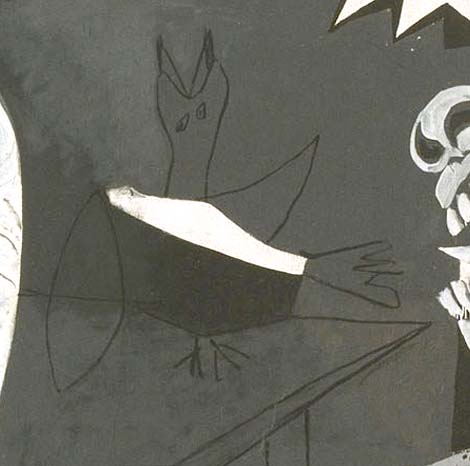
Siamo fortunati a vivere in un mondo in cui il dipinto di Picasso esiste ancora e che le forze che avevano cercato di zittire la sua voce, nel tempo furono invece sconfitte. L’immagine di Picasso continua a ricordare le atrocità della guerra e ci aiuta a ricordare che il pennello e la penna possono essere potenti armi per combattere l’oppressione.
We are fortunate to live in a world where Picasso’s painting still exists and that the forces that had tried to silence his voice, in time were silenced instead. Picasso’s picture continues to be a reminder of war’s atrocities and helps us to remember that the paintbrush, as well as the pen, can be mighty weapons to fight oppression.
Picasso è uno dei protagonisti del nuovo libro “Waking Isabella.” Per saperne più del romanzo seguite questo link.
Picasso is one of the protagonists of the new book “Waking Isabella.” To learn more about the novel click this link.
Potete comprare il libro su Amazon qui
You can buy the book on Amazon here
If you like this post you might like these too:
Waking Isabella Book Trailer Video
Venere di Botticelli – Perfect representation of female beauty in art
Elena Ferrante: Neapolitan novels discussed at San Francisco Istituto Italiano
Ponte Vecchio — Florence’s famous historic medieval landmark now canvas for art
